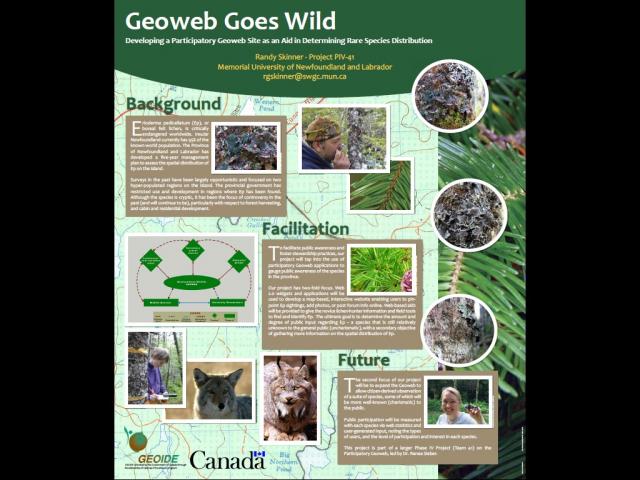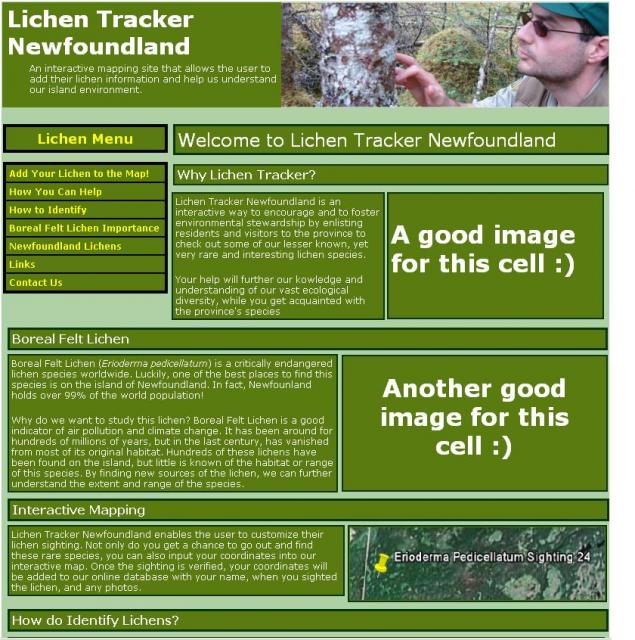HOT OFF THE PRESS (May 7, 2009): Here's a draft of our poster for the GEOIDE meeting. We'd love your feedback!

Feel free to add your comments, links here. TesTlink
This project led by Dr. Wiersma works towards the development of a Web 2.0 based interface to facilitate public engagement with the province of Newfoundland and Labrador’s Wildlife Division. More specifically, the goal is to develop a strategy for facilitating public engagement, reporting and monitoring of a rare lichen (Erioderma pedicellatum) on the island of Newfoundland.
January, 9, 2009: Erioderma Project Commencement (Randy Skinner, MSc Student)
I have been devoting my time and resources over the last 3 weeks developing a near-complete list of target and focus groups besides the Cottagers and natural history buffs as outlined in the initial project description. A more comprehensive listing or target audiences was completed. Details about what to put on such a website (content) is ongoing, with emphasis on how to identify Erioderma by a novice observer. This may be the most crucial part of the non-mashup/widget section of the website, as identifying E.p can be difficult. Care will be taken to give a step-by-step guide that can be easily printed to help would-be lichenologists a better chance at detecting and identifying E.p. Both work and study are ongoing on the types of mashups and widgets that would be appropriate for the project, as well as brushing up on my HTML coding and development skills.
January 1, 2009: Preliminary Website Design for Future Erioderma Web 2.0 Site.
Now that the New Year is upon us, it is time to herald in the new and exciting work that is being done over the last few months. I have started a website design for the Erioderma (Ep) web 2.0 site. Currently, I am developing the 1.0 content: the pages that will house the web 2.0 applications. This is essential because Ep is a rare and hard-to-find species, and a requirement on our part to describe visually and textually where and how to find Ep is essential. The website (Lichen Tracker is the current title, but it could change in the near future) will include a page for the web 2.0 material (mapping features and a hopefully interactive database management section, as well as a forum and/or photo gallery), but care has to be made on including pages on what Ep is, it's importance, and how anyone with a minimal amount of guideance (found on the website) can find Ep in the field.
That last part is probably the trickiest section of the site (excluding the web 2.0 content), as care must be given on how to best present such information to the public that will be succinct, concise and powerful enough so that people will be able to find Ep relatively easily.
Sample website page: Sample page for Lichen Tracker. Please note that it is a work in progress, and they blocky feel will evolve into something much more smoother.

December 7, 2008: Project Update (Pilot Phase)
Prior to this research there had been little application of the Geoweb by the Wildlife Division. In nearly all cases, staff members of the provincial Wildlife Division were not aware of what the participatory Geoweb entailed, nor were they familiar with concepts around Web 2.0. To address this Dr. Wiersma initiated a conference call with project partners and Dr. Renee Sieber, facilitating a Q&A session to raise the awareness of the potential for the Geoweb to assist with management goals within the Wildlife Division.
After conducting the session, Dr. Wiersma and project partners focused their attention on identifying who the ‘publics’ are with whom the Wildlife Division wants to engage, and in identifying strategies for facilitating engagement. Related to this, the project team had to develop a strategy for making the public aware of the Geoweb and develop a prototype for the website for review by members of the Wildlife Division for content, and beta-testing with select members of the provincial Wildlife Division and the Natural History Society. To achieve these objectives, Dr. Wiersma (1) facilitated a series of teleconferences between project members and staff at the provincial Wildlife Division and (2) used initial funds made available through GEOIDE to recruit a Masters in Environmental Science student to develop the pilot website, a predictive habitat model for Erioderma and model for PPGIS on the issue of rare lichens in Newfoundland.
During the Pilot Phase of this project, Dr. Wiersma and project partners have achieved the milestones as defined prior to the commencement of the research: (1) Identified who the key ‘publics’ are who should be targeted for a pilot phase of a ‘Lichen Geoweb’; (2) Identified strategies for engaging with these publics and advertising the opportunity for participation and (3) Developed a pilot website for the Geoweb – this is currently under review by members as outlined above and beta-testing is planned for early 2009.
July 18, 2008: Notes from Project Meeting
Notes from Meeting with Randy Skinner (MSc Env Student), Kirsten Miller (Wildlife Division GIS Tech), Yolanda Wiersma (Assistant Professor and Randy's supervisor).
We met via conference call to brainstorm the following question. We will follow this by investigating which websites actually exist, how much traffic they get, and whether our target publics are really using them. This will allow us to prioritize (high/medium/low) the sites in terms of targets for interfacing on the Erioderma project. After we identify and prioritize the targets, we’ll examine what tool(s) we’ll use (Geoweb, widget, etc.) for each audience.
Who is the public and where do they go (virtually)?
Captive audience
- Individuals who have applied for a cottage lot along Salmonier line
Computer literacy/social issues: Some may not be that computer savvy, and may only use computers for email and the internet (need to find out). May not use the web at all, although most Web 2.0 interfaces are pretty easy- Will have restrictions on what they can do on their cottage lot because of presence of Erioderma. Thus, likely to be value for the lichen.
Where they go: Cottage Association website? Facebook group for cottage groups in similar location, natural history websites, town site/municipality website, Newfoundland Sportsmen website, Cottage lifestyle websites (e.g. fishing, ATV, snowmobile), Tourism websites
Passive audiences
- People who live near known Erioderma locations (Bay d’Espoir, and Avalon) and have more awareness about the lichen
Computer literacy/social issues: Literacy will vary as above, as will value for lichen.
Where they go: Regional Facebook group, town site/municipality websites, Economic Development Board websites, Tourism websites, Harris Centre (regional development office at MUN)
- People in the rest of the province who are completely unaware of Erioderma
Computer literacy/social issues: Literacy will vary as above, as will value for lichen.
Where they go: Everywhere and nowhere specific
- Natural History Societies (Avalon and Western)
Computer literacy/social issues: large and active groups, outdoors active, knowledgeable
Where they go: their own websites, other Natural History Society websites, MUN Botanical Gardens, NL Lichen Research Group, Facebook groups, Nature Conservancy Canada website, Salmonier Nature Park Website, Pippy Park Website (Avalon), MUN Biology website, Sir Wilfred Grenfell College website, Geocacheing websites, MEC, the Outfitters, Protected Areas Association, CPAWS-NL, Western Newfoundland Environment Centre, the Rooms (provincial museum), Flickr
- Geocachers
Computer literacy/social issues: they love to look for and find things. Geoweb savvy. Possible issue because they also like to broadcast widely where they find things, which might be problematic for a sensitive species like Erioderma.
Where they go: Geocacheing websites, Facebook groups, MEC, the Outfitters, MUN Geography Website, Grenfell Website, East Coast Trail Association, NL Maps website, Flickr
- Schools, especially high schools with biology, environment programs (especially schools in the area).
Computer literacy/social issues: Teachers and high school students pretty web savvy.
Where teachers go: School boards, websites for individual schools (are not updated frequently), CPAWS-NL, PAA, Salmonier Nature Park, The Rooms (provincial museum)
- Conne River Mi’kmaw Band and schools.
Computer literacy/social issues: Computer literacy good among younger generation. Lots of folks in Conne River have a high degree of awareness about Erioderma.
Where they go: Band’s own website, townsite/municipal website, Jepujikuei Kuespem Provincial Park (Natural Areas Division website), Federation of NL Indians website, MANKA ?, outfitting camp websites (Bay du Nord Wilderness area), Facebook groups for specific camp/cottage locations
- Tourists – especially international natural history groups/lichenology groups
Computer literacy/social issues: Good level of literacy. Unless coming with a motivation to see a rare species, Erioderma is unlikely to be a draw for the average tourist.
Where they go: Gov’t tourism website, Salmonier Nature Park, NL Lichen Research Group website, the Rooms (provincial museum), Natural History Society Websites, MUN Botanical Gardens website, local tourism boards, Flikr
- Resource extractors – trappers/hunters/outftters/ATV and snowmobile user groups,
Computer literacy/social issues: people out in the woods a fair bit. Some will not want to find Erioderma on their area, others might be willing to look and will be happy to find it (e.g., owners of outfitting camps who want to keep logging roads out of their area). Mostly good computer literacy.
Where they go: NL Outfitters Association, individual outfitting camps websites, NL Trapping Association website, NL Outdoorsmen, Rod and Gun Club?, ATV and snowmobile groups websites/Facebook groups, Harris Centre, flickr